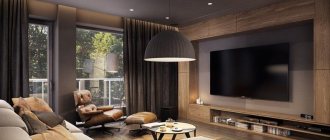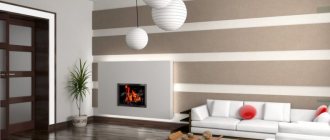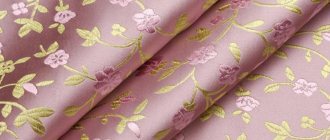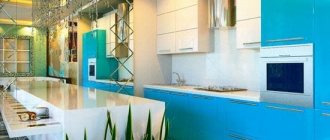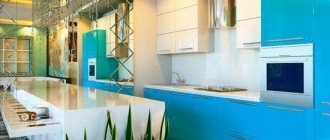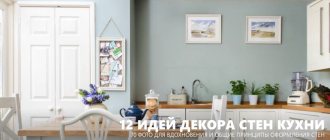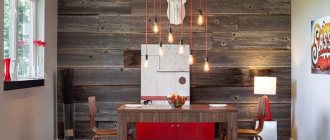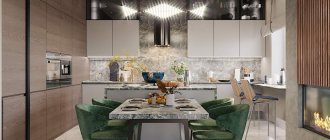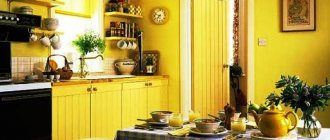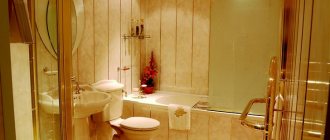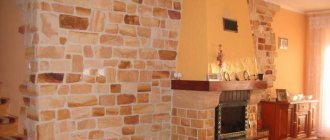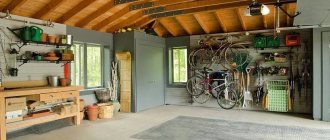The walls were decorated with fabrics in ancient times. Of course, not in the homes of ordinary citizens, but in the chambers of palaces. In later eras (for example, Baroque or Classicism), such decoration could be found in the houses of nobles. Fabrics occupied a special place in theaters: walls lined with them perfectly absorbed sound and created a cozy atmosphere, which was important for the viewer.
Suppressed by more modern materials (for example, paper wallpaper), they faded into history, only to return later. And today, wall decoration with fabric can be seen more and more often. But, as always, a number of questions arise before repairs - for example, about the advantages and disadvantages or about carrying out the work yourself. We'll talk about this further.
Pros and cons of fabric trim
Before choosing a finishing method, you need to find out what is good and bad about it. Therefore, it would be logical to first consider these issues and then move on to the specifics. Let's start with the advantages:
- no one will argue that walls decorated with fabric look very beautiful and original. And this, you see, is a plus;
- one of the finishing methods allows you to hide wiring and communications and even install some types of insulation;
- After many finishing materials (for example, decorative plaster), mountains of construction waste remain. But this is not about fabric;
- In some cases, installation can be carried out by one person;
- wide fabrics allow you to create a seamless coating, which the same wallpaper cannot;
- the finish is characterized by elasticity, that is, shrinkage does not affect it.
Now let's talk about the disadvantages:
- fabric, especially good one (for example, with water-repellent properties) is expensive;
- there are problems with the output of sockets and switches;
- some types of finishing work are complex;
- caring for a wall covered with fabric is not easy. So, since the material absorbs dust, the surface must be vacuumed. True, there are types that repel dust, but many people cannot afford them. In addition, you need to ensure that the wall does not get dirty, since removing stains is not so easy: cleaning solutions do a good job of this task, but they can ruin the color, especially if you do this work more than once (and the fabric can get dirty many times);
- the material is able to absorb odors. Therefore, it is better to refrain from using such finishing in the kitchen.
A good alternative to decorating walls with fabric is textile wallpaper.
Seamless gluing and the difficulties of its implementation
The height of the nursery wall allowed the fabric to be glued across. We made seamless wall coverings.
- We prepared the fabric, soaked it in salt, smoothed it well, and rolled it up facing inward.
- Starting from the corner, we coated the surface of the wall with casein glue, paying special attention to the perimeter.
Seamless wall covering with fabric
- The left end was secured. Kirill unfolded the cloth and straightened it, I ironed it with a hot iron, melting and fixing the glue.
- They cut a hole in place of the switch, and when they reached the opening, they cut the fabric according to the fact.
It’s difficult for me alone to cover the walls and smooth them out. We dealt with our nephew quickly. But I already have experience and have decorated walls with fabric in this way several times.
How to choose material
So, we have decided on the type of finishing. Now let's talk about how to choose material. First, let's look at the division into types. So, the fabrics are:
- natural (this includes, for example, brocade, linen, silk). This also includes mixed types, when, for example, wool or flax is added to cotton;
- artificial (viscose);
- synthetic (polyester, polyamide).
When choosing fabric, you need to take into account:
- How does it withstand exposure to sunlight? If it turns out that ultraviolet radiation contributes to fading, it is better to pass by;
- whether the material has undergone special treatment, which increases its service life. Of course, such fabric will be more expensive, but it is not afraid of dust, dirt and sun;
- features of the drawing. Of course, a faded ornament is not good, but too bright can cause fatigue;
Interior decoration with fabric upholstery instead of wallpaper on the walls: relevance in the interior
Page navigation
Using fabric to decorate the walls instead of the usual wallpaper will give the room a special shine and novelty. Many leading interior designers believe that paper wallpaper is a thing of the past, and the future of design art lies in fabric finishing. Its relevance is obvious:
- chic appearance;
- such repairs can be done with your own hands;
- not typical and novel design.
You can use any type of material: from thin linen to thick velvet, from the simplest textiles to expensive silk.
Mounting methods
Consider the options that allow you to mount the fabric on the wall:
- pasting. Features of this method are the use of furniture glue and iron;
- pulling. Here the fabric is attached to the rail;
- drapery. Creation of volumetric folds during finishing;
- upholstery, carriage tie. This is a rather original and very difficult method, although the result looks appropriate.
It is difficult to say which method is better. If we take the last two, some call drapery more complex, others - on the contrary, upholstery. However, the essence of the options does not change. Let's look at them in more detail.
Pasting
Without unnecessary controversy, this method can be called the most difficult. In this case, at least one assistant will be required for pasting. True, the result is worth it: the fabric looks on the wall like very expensive and original wallpaper. There is no frame provided here, so the wall, again, needs preparation. To carry out basic work you will need:
- furniture glue;
- iron (it’s better to get an old one, because it’s more powerful);
- knife;
- ruler;
- hammer with nails;
- needle.
Furniture glue is spread over the entire surface of the wall. There is no need to be afraid that it will instantly harden: the composition will not do this without heating. The perimeter needs to be coated more so that the edges do not fray later.
Now let's move on to the fabric itself. For convenience, one edge can be secured with a nail. Next, take an iron and smooth the top of the fabric with the iron; at this time, an assistant should hold this part until it sticks. The glue, when heated, sets and the fabric is thus fixed to the wall; There is no point in pulling it. It is better to grab a strip 50 cm wide so that the canvas is well secured on top.
Having reached the opposite corner, continue gluing work, using the iron to grab the same half-meter strips. At this time, your partner can trim the edges using a ruler and knife.
When the canvas is completely glued, look for bubbles on it; Having found it, pierce it with a regular needle and go through the iron again. It takes three days to search for and eliminate bubbles while the glue can be heated.
Pulling
This method is not complicated, although it cannot be called easy; An assistant will be needed to carry out the necessary work. You will also need:
- thin slats made of wood;
- fastening elements (for example, screws);
- hammer with nails;
- screwdriver;
- pencil.
First you need to mark on the wall with a pencil the places where the slats will be attached. There are several important points here. Firstly, the lines must be straight. This is checked by the building level. Secondly, the distance from the ceiling and from the floor should be the same.
When the lines are outlined, you need to secure the slats along them. Now their evenness is checked using the same level. Then the fabric is stretched over them. This is where you will need an assistant. The canvas should be as stretched as possible and, most importantly, even. In the place where the fabric is attached to the rail, it is better to fold it two or even three times. The material can be secured with nails; Also suitable are staples that are used for upholstering sofas. The fastening points are hidden using decorative skirting boards.
Drapery
There is another similar option called drapery. In this case, the canvas is not attached along the entire perimeter, but only at the top and bottom. Since it should be folded, there is no need to stretch the fabric. The cut itself must be wider than the wall in order to get these folds. By the way, perhaps this is why there is debate about the complexity of the method: this finishing is much simpler than the one described above, which is sometimes mistakenly also called drapery.
Before fixing, you need to prepare the wall and fabric. The surface must be cleaned, puttyed and sanded; the fabric is gathered into folds using pins, the upper part is stitched. Then the fastening occurs on the slats. You need to start from the top so that the fabric falls freely, and only then the bottom is attached to the bar.
Upholstery (carriage screed)
This method was used to decorate the carriages of nobles, hence the name. Those who have heard the word “capitonné” should say that this is one of the names of the finish.
In this case, the fabric is attached to the wall not entirely or in strips, but in panels. As their basis, you need to purchase MDF sheets. In addition, you will need:
- foam rubber 5 cm thick;
- padding polyester;
- drill. For it you need to get a tsifenbor attachment, which makes neat, even edges;
- decorative cord;
- cardboard;
- pneumatic stapler with staples;
- textile. We emphasize that a durable canvas is required here, since anything else will not withstand finishing work.
Now let's move on to creating the panels itself:
- take a sheet of MDF;
- glue foam rubber on top and adjust to size;
- make markings on a sheet of cardboard, cut out the places where the buttons will be attached;
- put the sheet on top, use a marker to trace the cut holes on the foam rubber;
- Using a drill with a tsifenbor attachment, we make holes of small depth;
- We glue the padding polyester on top of the foam rubber and make holes in it (so that they coincide with those below;
- we cover the entire structure with fabric, make holes in it too;
- drill out all layers completely (that is, right through);
- We are sewing buttons. Then you need to thread decorative cords into them;
- we pull the cords out to the wrong side, stretch them and fasten them with a stapler.
Thus, the panel with carriage screed is ready. All that remains is to fix them on the wall, and the finishing is ready.
Drapery – elegant walls of banquet halls
Decoration with soft cascading waves is used in halls for celebrations and banquets, in living rooms, and in preparation for a holiday. The photo shows fabric decor, which can be replaced quickly, step by step repeating simple steps with ready-made material. The fabric must be prepared:
- Sew a continuous fabric, wider than the wall, since the trim should hang in waves.
- Hem the top and bottom, maintaining the height of the partition.
- Starch and smooth.
- Attach to a strip or bamboo cornice.
Draping walls with fabric for a wedding
The advantage of this method is that you can quickly cover the walls and give the room a decorative and festive look. Then, in a short time, change the style and theme, decorate the room for the next celebration. The trim does not need to be glued; it is enough to temporarily hang soft draping material.
The advantage of drapery is the ability to quickly change the design, wash the fabric, use any finishing option in turn, inexpensively creating a stylish and elegant look. This option was not suitable for Kirill and me, since we are doing major renovations of residential buildings and apartments.
Bottom line
Decorating walls with textiles is a great way to create a unique design. Walls decorated with fabric look very beautiful. In addition, they create comfort in the home. True, finishing work is not so easy; In addition, the fabric needs additional care.
By the way, there are other options for fabric finishing. Thus, “Velcro” is somewhat popular: tapes are attached to the wall and fabric, and then combined. This allows you to remove the fabric for washing and reattach it. You can also purchase an installation system that also provides for the removal of finishing material. However, which method is better, everyone decides for himself.
Stylistic directions
You can decorate rooms in an original way using fabrics in completely different styles. The highlight is the use of fabric materials instead of conventional wallpaper. Fabric trim will look appropriate and beautiful in the following directions:
- Art Deco: for the direction it is recommended to select contrasting fabrics with large repeating patterns;
- modern: for styling in this direction, materials with abstractions, bright repeating patterns or special models with one large pattern (similar to photo wallpaper) are suitable;
- urban: for the style, plain fabrics of a light, soft color (or models with discreet patterns) will be preferable;
- ethnic style: fabrics with zigzag patterns of different colors are suitable for the direction;
- 50s style: bright fabrics with repeating flowing patterns will perfectly complement the direction;
- oriental: dark-colored materials with golden or silver patterns are suitable for the style;
- classic: an excellent solution would be to choose canvases with a dark background and eye-catching, repeating patterns and stripes.
Textile wallpaper
In the building materials market today there is an economical and easy-to-use method of finishing with fabric. As you might guess, we are talking about seamless textile wallpaper. The width of the strip can reach up to 3.5 meters, which allows you to glue wallpaper directly throughout the room, unwinding the roll horizontally. The process of gluing textile wallpaper is, in principle, quite similar to the process of gluing paper wallpaper. But there are some nuances, that is, it is worth considering the algorithm in more detail:
- Clean the surface of the rough wall.
- We measure the height of the walls.
- Cut the required piece from the roll.
- We apply glue to the upper edge of the strip; the glue should be applied to a strip no more than fifteen centimeters wide.
- Glue the textiles to the wall surface.
- You should wait until the material sets firmly.
- Then we apply glue either to the surface of the wall under the glued strip, or to the right and lower edges of the material.
- We carefully stretch the textile to prevent the formation of waves.
Video about gluing fabric wallpaper:
What interiors is it suitable for?
Textile coverings have always been used in classic, bohemian, baroque, empire, oriental and ethno motifs. They are characterized by dense printing, pronounced stripes, deep colors, and inclusions of gold threads.
Elements in pastel shades, with small floral or geometric patterns in Provence, retro, hygge, and shabby chic look no worse.
For urban design, Scandinavian houses and lofts, plain jeans, linen, knitwear, and velvet fabrics with unobtrusive tints are suitable.
Nuance! Large bright drawings and abstractions should be used with caution. They are appropriate in art deco, pop art, hi-tech. Fabrics can be used sparingly in any setting. It is only important to choose a harmonious combination of prints and textures.
Following some rules
When deciding to decorate a room with fabric yourself, you should take into account some requirements:
Completing the stages of work and following simple recommendations will be the key to successfully completed work, which will delight the eye with its uniqueness. Having decorated the room with fabric drapery, you can enjoy the sophistication of the interior and the comfort created by yourself.
Draping a wall with fabric in the bedroom Wedding draping a wall Fabric on the wall in the interior
Source
What are stickers like in use?
Before the first experience of sticking stickers on walls, questions arise about what surfaces they can be glued to, how they will behave, whether they will come off, whether they can be removed if you don’t like it or get tired of it, whether the surface will be damaged after removing the sticker, will there be any traces left? And so on. The questions are clear. Let's talk about all these nuances.
Wall stickers - a quick way to change your design
What surfaces can be glued to and how well will they stick?
You can glue on any surface that is not too embossed and not too soft and delicate. And not only on the walls, but also on the ceiling, furniture, doors, etc. So, what materials can stickers be applied to:
- For paint (including water-based paint).
- For wallpaper.
They stick normally to vinyl and non-woven materials. On smooth surfaces it’s generally very good, on a not very textured surface it’s not bad. With a relief surface - you have to try it, as the result is difficult to predict. You can stick it on soft paper ones, but you will most likely remove it with a piece of wallpaper. As you can see, it sticks well to vinyl embossed wallpaper - Furniture from any material. On painted facades too.
- On glass, mirror.
- Ceramic tiles.
- For metal (refrigerators).
In general, without question, stickers can be applied to any hard materials: smooth or with a not pronounced relief. The rest need to be checked. How? Some manufacturers include a sample sticker in each kit (DesignStickers, for example). In this case, glue this test sticker according to all the rules on the intended surface. Leave for 24 hours. After this period, check how the picture behaves. If it hasn’t fallen off in a day, the edges hold on, then in a year or two nothing will happen to it. If it comes off, look for another surface.
The best background is plain
But that is not all. You need to check if there are any traces left after removal. To do this, take and remove the test sticker. We remove it correctly: we pry up the top edge, wrap it and pull it down, and not “towards ourselves”. Usually, it comes off cleanly, without problems. If you are unlucky and some of the paint or fragments of wallpaper remain on the surface, look for another place.
What to do if there is no test sticker? Perhaps your wall decal consists of several pieces. Pick one small one, go through the whole process. Just do not remove the protective film (transparent). If it comes off without “wall fragments,” it can be re-glued. And for the third time. Maybe in the fourth... Depends on the adhesive composition and the strength of the film. But the walls must be clean.
Textile wall decoration: fabric requirements
The quality and attractiveness of the chosen drapery depends on the quality of the textile. Experts do not recommend using some natural materials, such as linen or cotton, and prefer synthetic or even mixed ones.
Optimal types of decor textiles:
- natural fabrics - jacquard, jute or sisal;
- from artificial fabrics - viscose, polyester or polyamide.
These fabrics do not stretch, do not sag over time, and are easy to work with. To increase sound insulation, it is better to use heavy fabrics, such as jacquard. In a room with high humidity, use synthetic materials treated with a moisture-repellent composition.
Tile
Ceramic tiles are compressed slabs made from a mixture of clay, sand, quartz and carbonates and fired at high temperatures. The tile is so dense that it does not allow water and grease to pass through, does not absorb unpleasant odors and does not allow mold to form.
Tile is much stronger than concrete, so it can withstand heavy loads. Excellent for covering kitchen splashbacks and bathrooms - this is one of the most practical and popular types of finishing.
Despite the wear resistance and durability of the material, transportation and laying of tiles must be done very carefully: thin plates easily split upon impact. To extend the life of the material, do not skimp on tile adhesive and latex grout.
Where is it used?
Plain or designer fabric is used to decorate the walls. Some brands produce such materials on purpose.
Canvases come in different textures, colors, and densities. But still, they are all similar in basic qualities, because it is a matter made of fibers.
Please note: fabric should not be used in rooms with high humidity and increased fire risks. The method is not suitable for rooms where constant contact with the walls cannot be avoided.
Such walls fit appropriately and practically into the interiors of bedrooms, living rooms, and offices.
Some elements look good in hallways and dressing rooms.
Restaurants, hotels, clubs for VIP areas love the reception.
Important! When choosing a location for placing fabric, it is important to think in advance about the possibility of proper care. If cleaning is difficult, it is better to abandon large volumes or replace the finish altogether. The entire room is rarely covered with fabric.
Bedrooms
The main recreation area has the widest range of uses.
With fabric you can make:
headboard without built-in headboard
accent place opposite the bed
walls around a separate window or window groups
Draperies, combinations with colors, and imitation canopies made of material and drywall look original.
Living rooms and offices
Zoning with fabric for the television and dining area, workplace and reading corner looks beneficial. The scope of imagination is limitless.
Here it is important to select materials that are similar in density to furniture upholstery, carpets and curtains.
Pasting with stripes similar to wallpaper
Instead of paper wallpaper, strips of fabric are glued to the wall. The texture is chosen dense. The technology partly differs from the method of pasting with rolled finishing material. We had to stick fabric with a luxurious pattern in the living room with our own hands.
Frame diagram for draping walls with fabric
Before finishing, it is recommended to check a piece of fabric for shrinkage. I prefer to soak all the fabric that is used for finishing. Industrial dust and oil from equipment are washed away from it. At the same time, I dissolve the salt in water, fix the paint, brighten the color of the fabric base, and make the material non-flammable. The texture of the fabric becomes denser. Now it fits better on the wall and attracts less dust. I had a large work table on which the fabric was ironed before cutting. The stripes are narrow, so they were glued like regular wallpaper.
The top edge can be secured with nails, then trimmed using lace or fringe.
Dye
The popularity of wall paints is explained by many advantages: relative ease of application, a wide selection of varieties for all types of rooms, versatility and ease of surface care. But not all paints are suitable for decorating walls in an apartment: fortunately, the modern market offers countless types of material.
When purchasing paint, do not focus only on price. Cheap paints and varnishes are short-lived and quickly lose their appearance. Before purchasing, study the labels on the cans: manufacturers indicate for which rooms a particular composition is suitable.
Water-dispersion latex-type paints are resistant to moisture and mechanical stress. But acrylic paints have the most reasonable price-quality ratio - they are not afraid of ultraviolet radiation, humidity and remain in their original form for a long time.
The listed materials will allow you to make practical repairs in your apartment and not have to worry about the decoration of the walls for many years to come.
